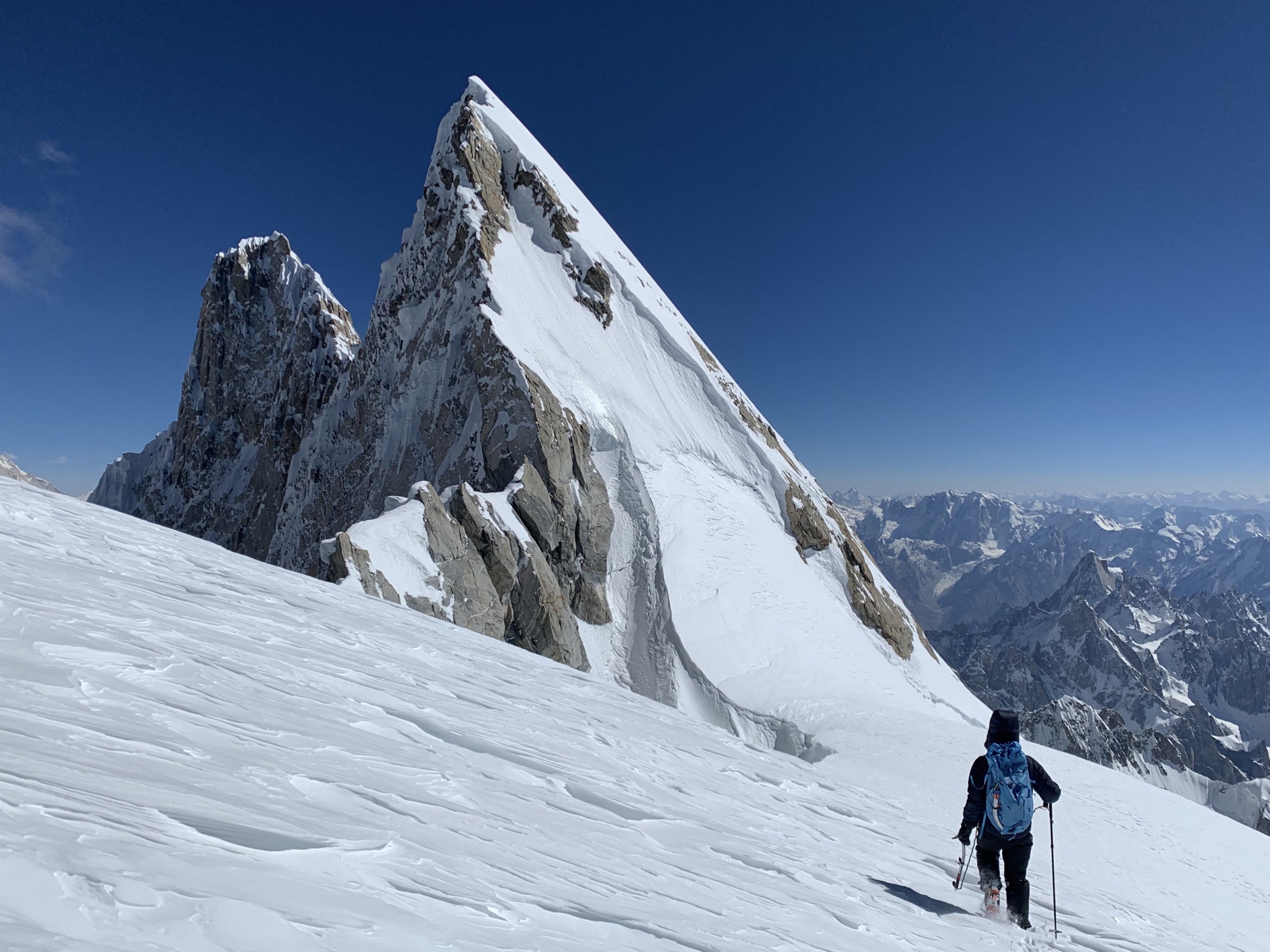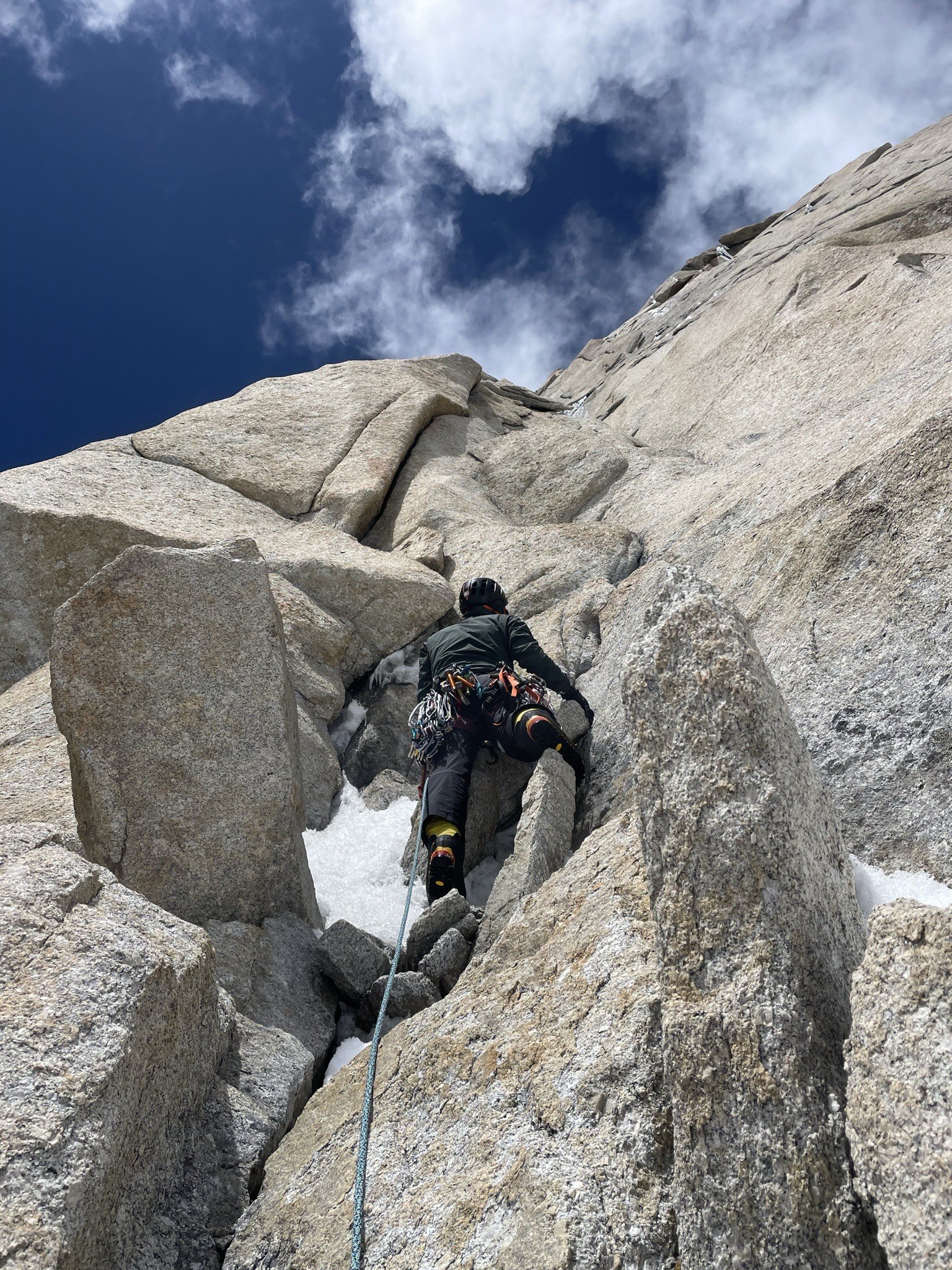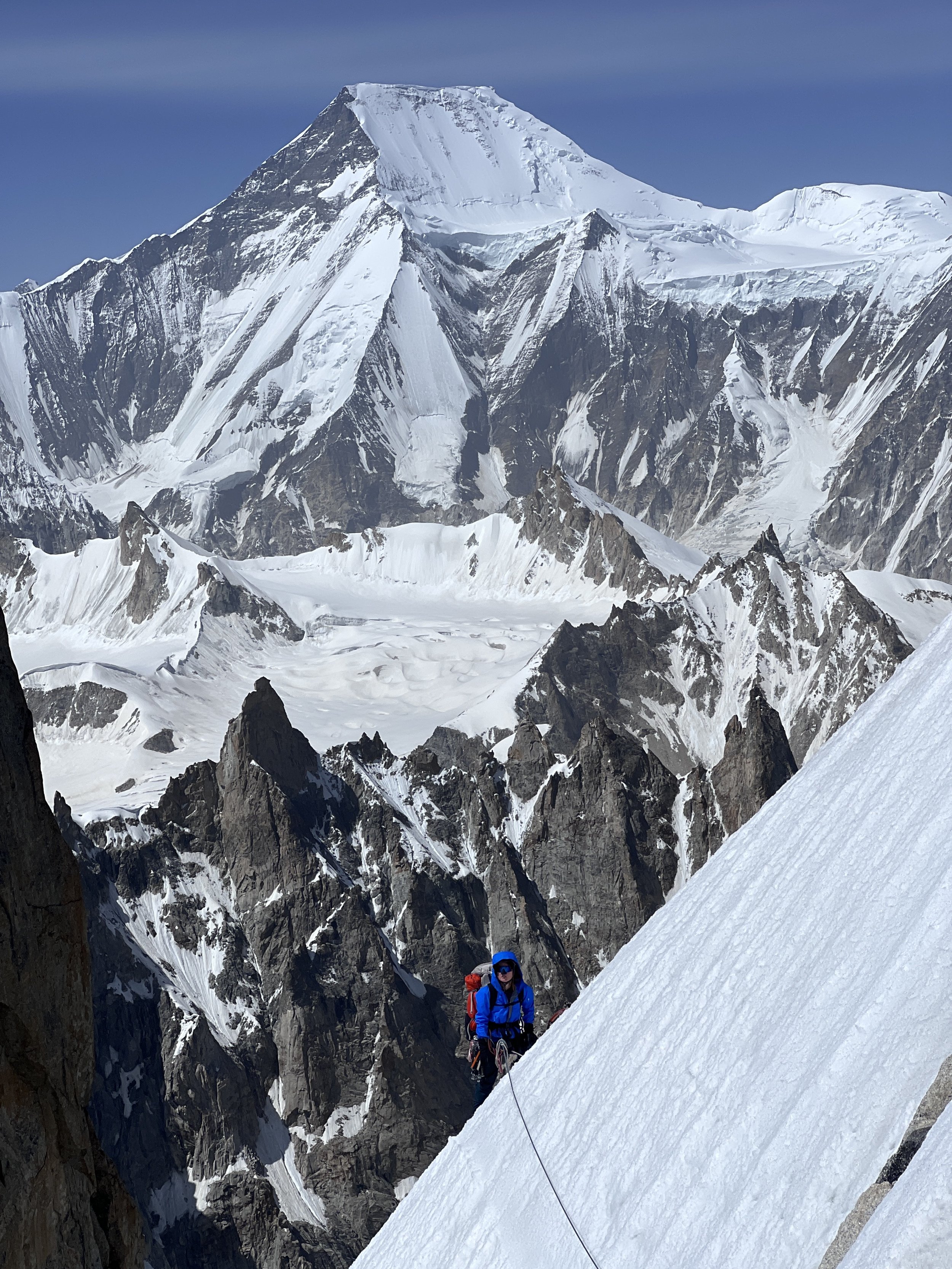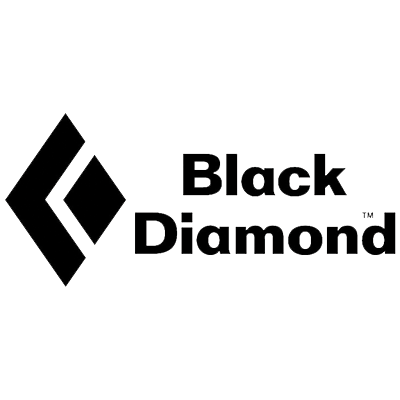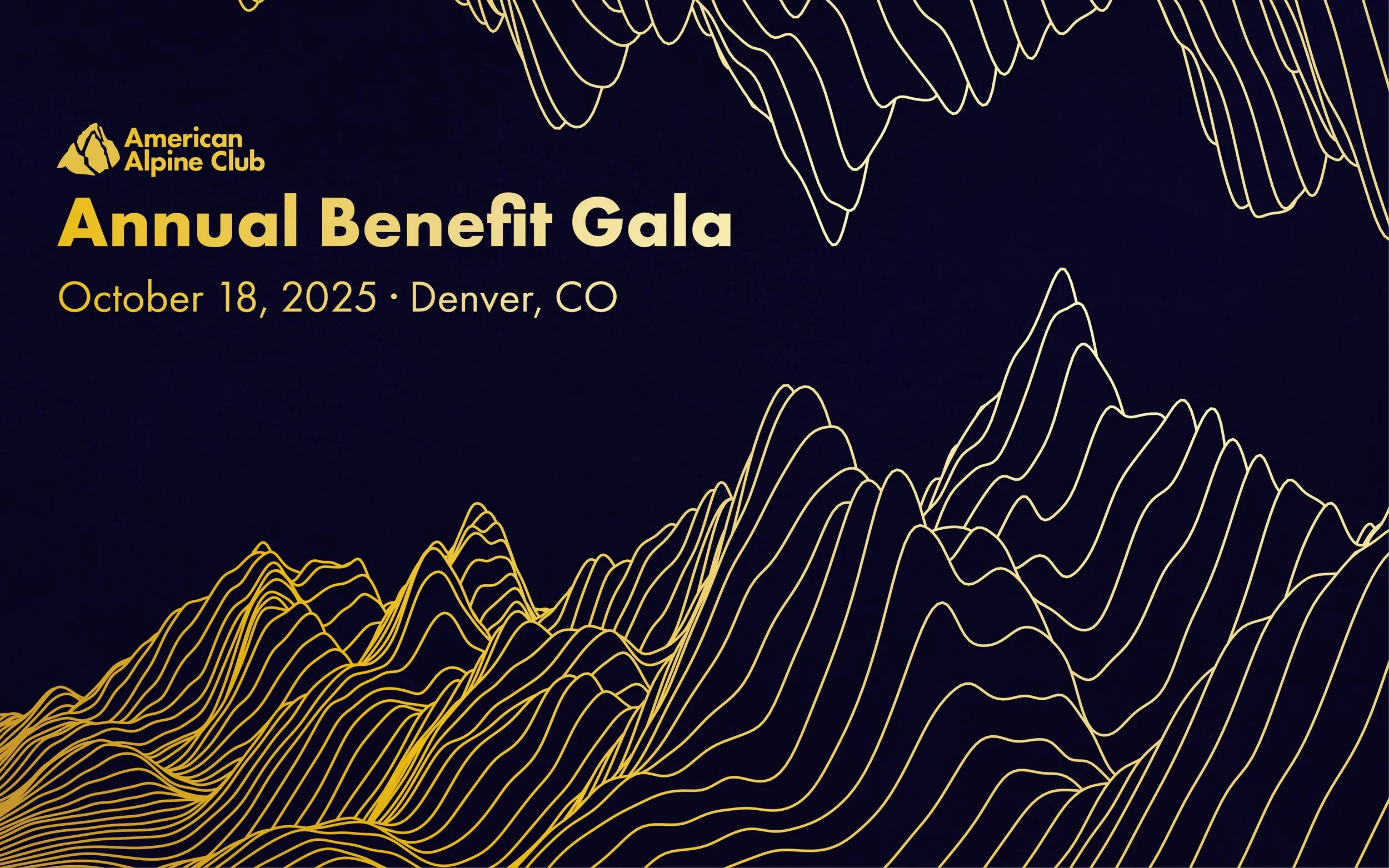PC: Jeff & Priti Wright
By: Sierra McGivney
First ascents and new lines on faraway mountains fill the American Alpine Journal every year. American Alpine Club members and climbers in the community browse the AAJ annually, reading stories about cutting-edge ascents. Some might even wonder to themselves, how do you dream up the next cutting-edge thing?
Beyond producing the AAJ, the American Alpine Club has a legacy of encouraging and inspiring climbers to push their limits and dream big through our grants. In 2022, Jeff and Priti Wright won our Cutting Edge Grant, sponsored by Black Diamond, to attempt K7 Central. This year, Lindsey Hamm won the Cutting Edge Grant and also our McNiell-Nott Grant, sponsored by Mountain Hardwear. They are each cutting-edge alpinists who are in pursuit of world-class climbing and mountaineering objectives. And they have answers to the questions you've been wondering about.
Step One: Light the Fire
Priti and Jeff Wright are a wife and husband duo based in Seattle who have been featured in the AAJ three times and on The Cutting Edge podcast. Their blog Alpine Vagabonds details their first ascents, alpine endeavors, and how-tos. Some of their most notable accomplishments are the first ascent of K6 Central (7,155m), the third ascent of K6 West (7,140m), all four peaks of Patagonia's Torre Range, and "The Six Classic North Faces of the Alps." But how did two-weekend warriors become cutting-edge alpinists?
Jeff and Priti on K6. PC: Jeff & Priti Wright
In 2017, The Mountaineers, a nonprofit climbing club based in the Pacific Northwest, held a talk featuring Graham Zimmerman, professional alpinist and AAC president, at their local gear shop in Seattle. It inspired the Wrights, so they approached him after the talk. Over drinks with Zimmerman, they talked about planning trips and their goals. They were excited about doing something new. The Greater Ranges in the Himalayas had caught their attention.
They asked Zimmerman about K6 Central, which he had attempted. They were interested in climbing it themselves. Zimmerman said something along the lines of, "Go send that sh*t." The two were stoked that Zimmerman had been so encouraging and kind.
"In the climbing community, almost everyone you reach out to is friendly and nice because they were in your position at one point," said Priti.
So for their first trip, they rode Zimmerman's coattails. According to Jeff, this is fairly common in the climbing community—failed expeditions can be a great opportunity for someone looking to make a first ascent. But you don't want to scoop someone's line, so contact the person first and see if they will make a second attempt at it. If they aren't planning to, they might even help you out and give you some extra beta.
Step Two: Plan An Expensive Glorified Camping Trip
On this first trip to Pakistan to climb K6 Central, Priti and Jeff learned a lot. Big expeditions are like glorified camping trips with lots of extra stuff, according to the Wrights.
PC: Jeff & Priti Wright
Logistics to be considered when planning a big expedition are:
Visas
Permits
Tour operators
Satellite devices
Weather
Power sources
Budget
Food
Shower
Washing clothes
They use spreadsheets and checklists to stay organized. Once you've figured out logistics, you can focus more on the climbing or technical aspect of your trip. The two got a lot of advice from Steven Swenson and Colin Haley on what food to bring and what airlines have the best baggage deals. Knowing someone who has gone on an expedition before can be a huge asset.
If you're wondering how to budget and get your trip funded, look into mountaineering grants. The AAC has quite a few for all different types of trips. Mountaineering or skiing/splitboarding based? We got you. Research or breaking barriers based? We got you. Have a climbing dream of any kind? You guessed it—we have a grant for you.
Step Three: Leave No Trace? Leave the Right Trace.
This is Lindsey Hamm’s second trip to the Churakusa Valley. This year, she's backed by the Cutting Edge Grant and the McNeill-Nott Grant.
"I'm thankful and grateful to have another opportunity," said Hamm.
Last year she, Dakota Walz, and Lane Mathis established a first ascent on a formation between Spanster Brakk and Naisa Brakk (which they named Ishaqu Brakk): Pull Down the Sky (15 pitches, 5.11 R).
Hamm is always excited about seeing the porters, cooks, and guides she's worked with again and continuing to build a relationship with the community in the valley. There is beauty in being around people who have a different life than hers. She becomes a student again.
This year, Hamm's group is bringing over school supplies and paying teachers their salaries for the year. For Hamm, climbing is about community, not just the climbing community.
Jeff and Priti have the same attitude. They advocate for climbing responsibly and contributing to the community where they are climbing. Alongside Steve Swenson, they work with Iraq Fund, an organization that helps girls go to school.
"It's not just about 'how you can help the climbing community' but the greater community as well," said Priti.
Step Four: Listen Closely for Unclimbed Peaks
K7 Expedition. PC: Jeff & Priti Wright
For the Wright's 2022 K7 Central trip, expectations were low. The idea was original and supported by the Cutting-Edge Grant. The inspiration for this trip was found at another mountaineer's talk. This time it was Steven Swenson who presented. He mentioned that K7 Central was unclimbed. They noted this and added it to their list of climbing ideas. There was a limited amount of information out there once they started looking into it. But that didn't deter them in the slightest.
"It's so difficult to try to come up with your own original idea in the Greater Ranges," said Jeff.
Half of the work is finding an objective that has yet to be done. Many of the Greater Ranges' mountains have little information on them, so it takes a decent amount of work just to look up a mountain and see what's been done.
The Wrights have spent hundreds of hours looking through documents in the AAC Library and the AAJ, searching for information on cutting-edge ascents. The AAC library uniquely holds so much history and resources for planning expeditions.
With a lack of information, the expedition became exploratory. They were unsuccessful in 2022 but are going to go back this summer to try K7 Central again.
Step Five: Devour Audio and Video Inspiration
"Getting inspired by listening to podcasts like The Cutting Edge and following people on Instagram, reading things that people have written, makes it seem a little more possible, and it gets those gears turning of, well, what might I be able to do?" said Priti.
Jeff and Priti's go-to podcasts to feed the stoke:
The Cutting Edge podcast
The Run-Out
Climbing Gold
The Enormocast
Alpinist
The Firn Line
Uphill Athlete
Evoke Endurance
Training for Climbing
Books:
The American Alpine Journal
Seriously, the AAJ contains trip reports for areas relevant to your expedition—Lindsay, Priti, and Jeff each swear by it.
Anything relevant in the AAC Library
Training for the New Alpinism: A Manual for the Climber as Athlete
Training for the Uphill Athlete
Step Six: You've Figured Out Where You Want to Go—Time to Train
For the last six years, Jeff and Priti have been in the Uphill Athlete Program, a training program with daily workouts made for different uphill pursuits. You might have seen or read the book Training for the Uphill Athlete; essentially, this is an extension of the book. They have been focusing on the endurance aspect of training and bringing it into the mountains. The biggest thing for them when putting together a plan is to focus on their goal.
"You have to break it down to, what are you training for? What are the exact specs of the thing you want to do?" said Priti.
PC: Jeff & Priti Wright
If your goal involves a lot of steep inclines, get your cardio high. At altitude, that's what you'll start losing first. If your goal involves a lot of technical climbing, you'll want to focus on strength training. At a certain point, you’ll have enough technical skills to accomplish your objective, and you can focus more on your muscular endurance and aerobic capacity.
The Wrights have big long objectives, so they focus on endurance-type training. Training is a huge part of alpinism or any big objective. It can help mitigate some risks. When you're at altitude and stressed out, having a reserve of energy can be huge.
"This weekend, all of our friends are going out rock climbing, and I'll be carrying a heavy pack up a steep muddy trail; just very monotonous and antisocial," said Jeff. "But it's nice to have a big objective that you're working towards."
Priti keeps a photo of her climbing goals or objectives on the background of her phone and on her credit card. It's a reminder of what she's working towards and saving up for.
Step Seven: Build Partnerships and Positivity
The Wrights have the benefit of being married to their climbing partner. They live together so they can feed off of each other's excitement. They know each other extremely well and know their communication style. Their situation is unique. The majority of partnerships don't have this dynamic—but one piece of advice that can be applied to every partnership? Don't share negative thoughts.
PC: Jeff & Priti Wright
"You can always put a positive spin on something," said Priti.
If you're not stoked about something, ask yourself, is this really worth sharing? Expeditions can be miserable but well worth it. Keeping both your energy and the energy of others high can be a huge factor in completing your goals.
There is also a balance between sharing safety or logistical concerns and being negative. If you are concerned for your or your group's safety, definitely speak up. Take your time with safety skills when training, too. They are necessary out in the mountains. To keep up their skills, Jeff and Pritit teach classes on climbing safety skills through BOEALPS. What's that old saying? The best way to learn is to teach.
If you enjoy learning, try and find a local group or guiding company that teaches mountaineer or alpine skills. At one point, Jeff and Priti were in a program run by Steve Swenson designed to instruct and mentor up-and-coming alpinists. Listening to Swenson's stories inspired the two. Knowing someone who had climbed in the alpine a lot made it feel more possible.
Step Eight: No Really, Partnership is Crucial
"I'm in four different relationships, and that is with all of my climbing partners," said Hamm.
She likens these relationships to romantic partners. She speaks with each of them on a daily basis to build trust and learn how each communicates. Expedition partners add another layer of friction, good and bad. They need to be able to adapt, work and think as a group. After the trip, Hamm's goal is to return together as a healthy family.
"I'm hype-girl Hamm," said Hamm.
She's also building a relationship with the mountains, getting to know the valley and Pakistan. She's trying to understand what friction exists there, whether that is the political climate or the actual climate.
Step Nine: Seek the Friction
In climbing, friction is all around us. It's created by partners, belay devices, knots, and the climbing rubber on our shoes.
"I think the fact that I have created a little bit more friction for myself …[allows me to seek] a different level of climbing that I've never experienced," said Hamm. "I have taken a lot of time to learn on a smaller scale to be able to go bigger."
Photo provided by Lindsey Hamm.
For Hamm, this isn't her first pitch. This is a culmination of ten years of guiding, learning, and understanding the disciplines: big wall climbing, skiing, ice climbing, mixed climbing, trad climbing, and glacial travel. Big expeditions take her out of her comfort zone and create a new layer of friction: the unknown.
"I really like the unknown," said Hamm with a smile.
She's on her way to the Black Canyon of the Gunnison to train for her upcoming trip. Her focus for this trip will be to work on her breathing, moving slowly and more meticulously. The Black Canyon is a lot like Pakistan—very adventurous, and strengthens the fingers.
"You can feel how the pioneers did it," said Hamm.
She'll head to Washington after The Black for altitude training, a different type of friction. Donning a heavy pack, she'll spend days going up and then down, acclimatizing to higher altitudes. The friction here is not seen but felt in the lack of air and the final push of training.
The environment, the people, and the climbing excite her. She looks over old photos and her grant proposal to stay motivated, but in general, she is a highly motivated, goal-oriented person, in part because of her ADHD. This trip is her lead, her idea.
"I'm living my dream," said Hamm.
Livin’ the Dream
PC: Jeff & Priti Wright
For Priti, Jeff, Lindsey, and many others, these expeditions are their dreams. They all started out learning and honing their skills: the tuned eye it takes to notice a first ascent opportunity; or leveraging and learning from the friction as they pushed harder and harder. They explored what motivated them and what made them excited.
Seek out what excites you the most. Go to talks, read books, and listen to podcasts that inspire you. Be comfortable being uncomfortable. Soon those stunning lines on faraway mountains won't seem so far away anymore.

